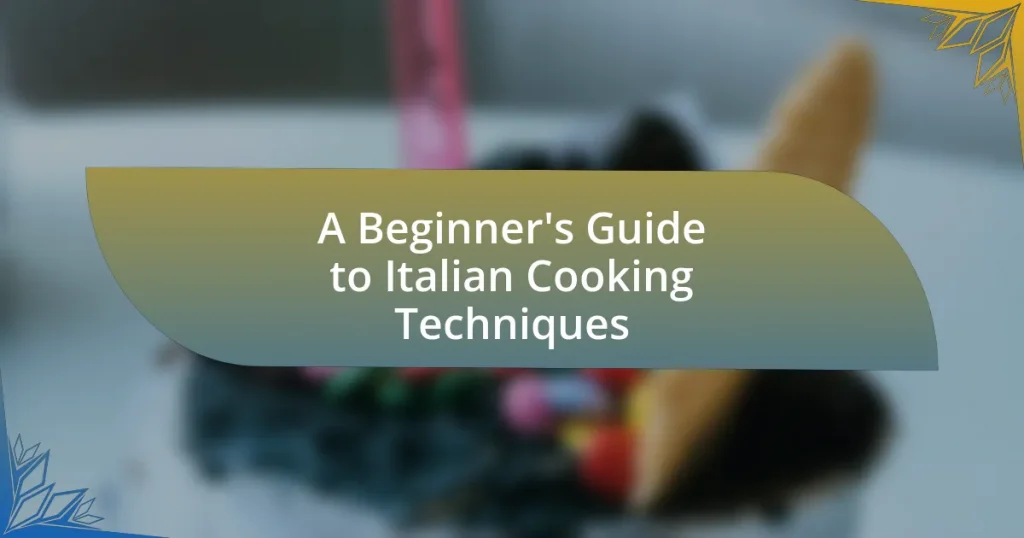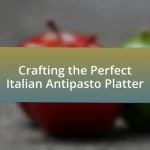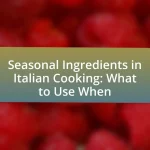The article provides a comprehensive overview of fundamental Italian cooking techniques essential for beginners. It covers key methods such as sautéing, braising, roasting, grilling, and making sauces, highlighting their unique characteristics and differences from other culinary styles. The significance of high-quality ingredients, regional variations, and traditional practices is emphasized, along with practical tips for mastering these techniques. Additionally, the article addresses common mistakes to avoid and offers simple recipes for practice, ensuring that readers gain a solid foundation in authentic Italian cooking.
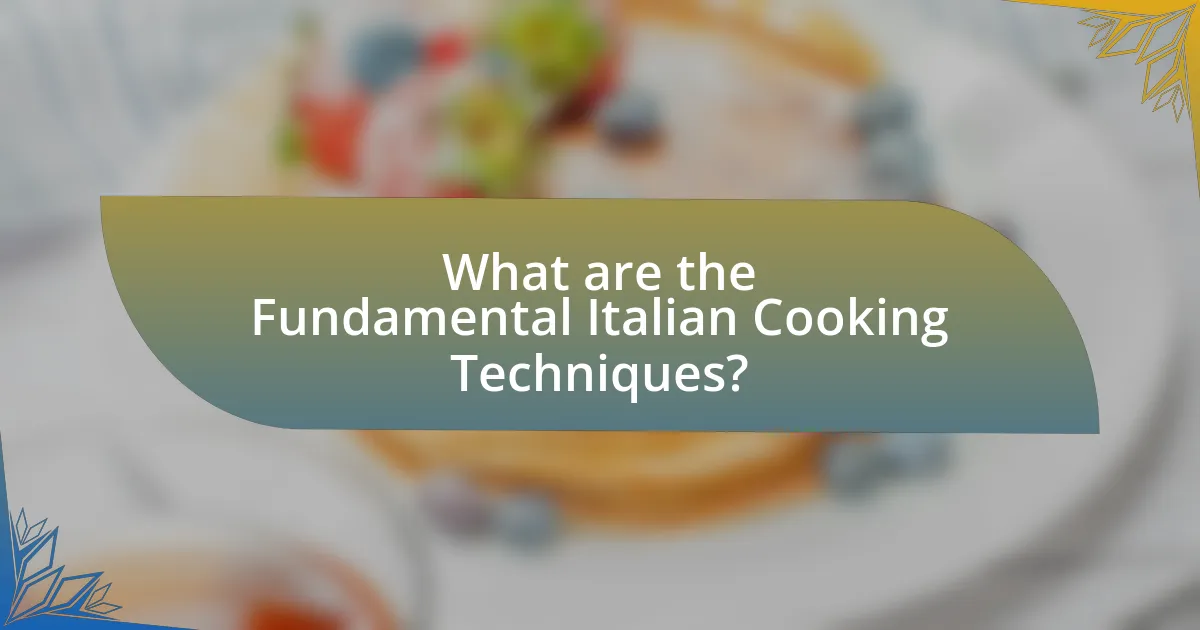
What are the Fundamental Italian Cooking Techniques?
The fundamental Italian cooking techniques include sautéing, braising, roasting, grilling, and making sauces. Sautéing involves cooking food quickly in a small amount of oil over high heat, which enhances flavors and textures. Braising combines both dry and wet cooking methods, typically involving searing meat and then cooking it slowly in liquid, resulting in tender dishes. Roasting uses dry heat in an oven to cook food evenly, often enhancing natural flavors through caramelization. Grilling involves cooking food over direct heat, imparting a smoky flavor. Making sauces is essential in Italian cuisine, with techniques like emulsifying and reducing being crucial for creating rich, flavorful accompaniments. These techniques form the backbone of Italian cooking, allowing for a diverse range of dishes and flavors.
How do these techniques differ from other culinary styles?
Italian cooking techniques differ from other culinary styles primarily in their emphasis on fresh, high-quality ingredients and traditional methods that prioritize simplicity and flavor. For instance, techniques such as sautéing, braising, and making sauces from scratch are foundational in Italian cuisine, contrasting with more complex or heavily processed methods found in some other culinary traditions. Additionally, the Italian approach often involves regional variations that highlight local produce and culinary heritage, which is less common in cuisines that rely on standardized recipes. This focus on locality and seasonality is supported by the Mediterranean diet, which has been recognized for its health benefits and cultural significance, as noted by the UNESCO designation of Mediterranean cuisine as an Intangible Cultural Heritage of Humanity.
What are the key characteristics of Italian cooking methods?
Italian cooking methods are characterized by simplicity, freshness, and regional diversity. These methods emphasize the use of high-quality, seasonal ingredients, often prepared with minimal intervention to highlight their natural flavors. Techniques such as sautéing, braising, and roasting are commonly employed, reflecting a balance between tradition and innovation. For instance, the Italian method of slow cooking, particularly in dishes like ragù, allows flavors to develop deeply over time, showcasing the importance of patience in Italian cuisine. Additionally, the use of fresh herbs and olive oil is prevalent, enhancing the dishes without overwhelming them. This approach not only preserves the integrity of the ingredients but also aligns with the Italian culinary philosophy of “less is more.”
Why is understanding these techniques essential for beginners?
Understanding Italian cooking techniques is essential for beginners because these foundational skills enable them to create authentic dishes and appreciate the culinary culture. Mastery of techniques such as sautéing, simmering, and pasta-making allows beginners to replicate traditional recipes accurately, ensuring flavor and texture are preserved. Research indicates that hands-on practice of these techniques enhances culinary confidence and creativity, leading to improved cooking outcomes. For instance, a study published in the Journal of Culinary Science & Technology highlights that novice cooks who engage in technique-focused training demonstrate a significant increase in both skill level and enjoyment of cooking.
What are the most common Italian cooking methods?
The most common Italian cooking methods include boiling, sautéing, roasting, grilling, and baking. Boiling is often used for pasta and vegetables, while sautéing involves cooking food quickly in a small amount of oil over high heat, commonly seen in dishes like risotto. Roasting is a method used for meats and vegetables, enhancing their flavors through dry heat in an oven. Grilling, popular for meats and vegetables, imparts a smoky flavor, and baking is essential for preparing pizzas and breads. These methods are foundational in Italian cuisine, reflecting the emphasis on fresh ingredients and simple techniques.
How is boiling used in Italian cuisine?
Boiling is a fundamental cooking technique in Italian cuisine, primarily used for preparing pasta and vegetables. In Italian cooking, pasta is traditionally boiled in salted water until al dente, which enhances its flavor and texture. This method is essential for dishes like spaghetti, fettuccine, and gnocchi, where the boiling process ensures the pasta cooks evenly and retains its shape. Additionally, boiling is employed to blanch vegetables, such as green beans and broccoli, which helps preserve their color and nutrients before further cooking or serving in salads. The importance of boiling in Italian cuisine is underscored by its role in achieving the desired consistency and taste in various dishes, making it a crucial technique for both home cooks and professional chefs.
What role does sautéing play in Italian dishes?
Sautéing is a fundamental cooking technique in Italian cuisine that enhances flavor and texture. This method involves cooking ingredients quickly in a small amount of oil or fat over high heat, allowing for the development of rich, complex flavors while preserving the ingredients’ natural moisture and nutrients. For example, sautéing garlic and onions at the beginning of a dish creates a flavorful base that infuses the entire recipe, a common practice in many traditional Italian sauces. This technique not only contributes to the overall taste but also helps in achieving the desired consistency and aroma characteristic of Italian dishes.
Why is roasting a popular technique in Italian cooking?
Roasting is a popular technique in Italian cooking because it enhances the natural flavors of ingredients while providing a rich, caramelized exterior. This method allows for even cooking and the development of complex flavors, which are essential in traditional Italian dishes. For instance, roasting vegetables like peppers and eggplants intensifies their sweetness and adds depth to sauces and side dishes. Additionally, roasting meats, such as porchetta, creates a crispy skin that contrasts with tender, juicy meat, a hallmark of Italian cuisine. The technique is rooted in Italy’s culinary history, where communal meals often feature roasted dishes, reflecting the culture’s emphasis on shared, flavorful experiences.
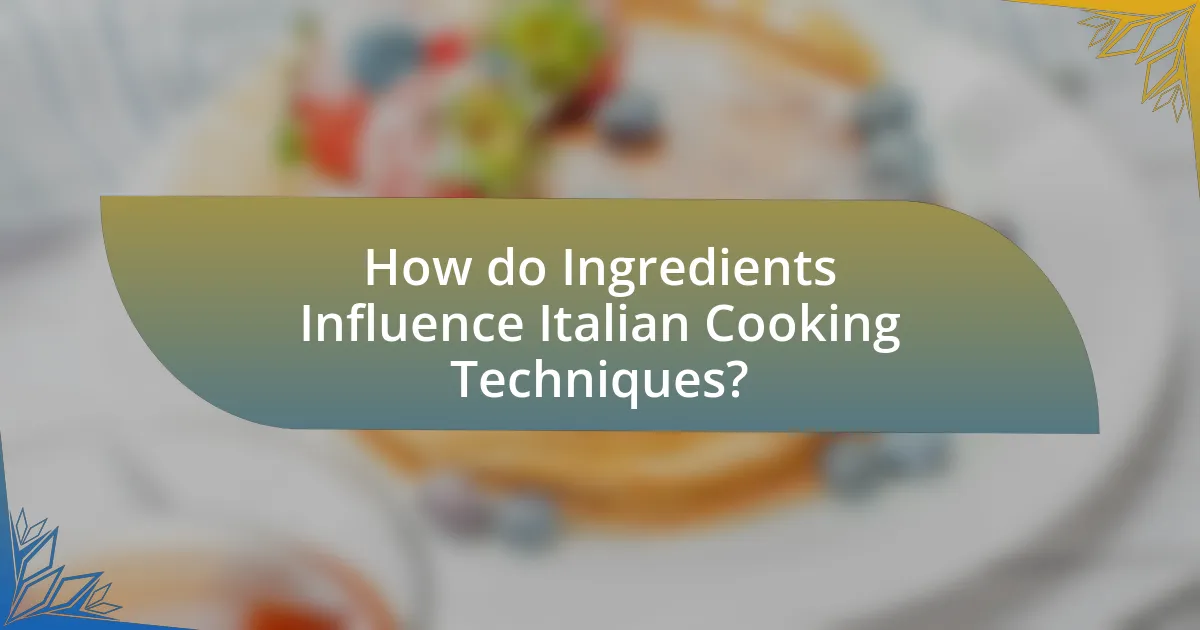
How do Ingredients Influence Italian Cooking Techniques?
Ingredients significantly influence Italian cooking techniques by dictating the methods used to prepare and combine them. For instance, the use of fresh herbs like basil and parsley often leads to techniques such as chiffonade or infusing oils, which enhance the flavor profile of dishes. Additionally, the quality of ingredients, such as San Marzano tomatoes, necessitates techniques like slow simmering to develop their natural sweetness, as evidenced by traditional marinara sauce recipes. Furthermore, the regional availability of ingredients, such as seafood in coastal areas, influences techniques like grilling or sautéing, which are preferred for preserving the freshness of the catch. Thus, the choice and quality of ingredients directly shape the cooking methods employed in Italian cuisine.
What types of ingredients are essential in Italian cooking?
Essential ingredients in Italian cooking include olive oil, tomatoes, garlic, fresh herbs, and cheese. Olive oil serves as a primary fat for cooking and dressing dishes, while tomatoes are foundational for sauces and salads. Garlic adds depth of flavor, and fresh herbs like basil and oregano enhance the aroma and taste of various recipes. Cheese, particularly varieties like Parmesan and mozzarella, contributes richness and texture to many traditional dishes. These ingredients are integral to the authenticity and flavor profile of Italian cuisine, reflecting its regional diversity and culinary traditions.
How do fresh herbs enhance Italian dishes?
Fresh herbs enhance Italian dishes by adding vibrant flavors, aromas, and nutritional benefits. The use of herbs like basil, oregano, and parsley is fundamental in Italian cuisine, as they elevate the taste profile of sauces, meats, and vegetables. For instance, basil is a key ingredient in pesto and Caprese salad, providing a fresh, aromatic quality that complements tomatoes and mozzarella. Oregano, often used in tomato sauces and pizza, contributes a warm, earthy flavor that enhances the overall dish. Additionally, fresh herbs contain antioxidants and vitamins, contributing to the healthfulness of the meal. Their incorporation not only enriches the culinary experience but also aligns with traditional Italian cooking practices that emphasize the use of fresh, local ingredients.
What is the significance of quality olive oil in cooking?
Quality olive oil is significant in cooking because it enhances flavor, provides health benefits, and serves as a versatile cooking medium. The rich taste of high-quality olive oil can elevate dishes, adding depth and complexity, which is particularly important in Italian cuisine where the oil is often a primary ingredient. Additionally, quality olive oil is rich in monounsaturated fats and antioxidants, contributing to heart health and reducing inflammation. Studies, such as those published in the “Journal of Nutritional Biochemistry,” highlight that the consumption of extra virgin olive oil is associated with lower risks of chronic diseases. Thus, using quality olive oil not only improves the sensory experience of meals but also supports overall health.
How do regional ingredients affect cooking techniques?
Regional ingredients significantly influence cooking techniques by dictating the methods and styles used in food preparation. For instance, in Italy, the availability of fresh seafood along coastal regions leads to techniques such as grilling and poaching, which preserve the delicate flavors of the fish. Conversely, in mountainous areas where livestock is more prevalent, techniques like braising and slow-cooking are common to tenderize tougher cuts of meat. This adaptation to local ingredients ensures that the cooking methods enhance the natural qualities of the food, reflecting the culinary traditions and environmental conditions of each region.
What are some examples of regional variations in Italian cooking?
Italian cooking exhibits significant regional variations, with distinct ingredients and techniques defining each area. For example, in Northern Italy, particularly in Lombardy, risotto is a staple dish, often made with Arborio rice and flavored with saffron, while in Southern Italy, especially in Campania, pizza is a hallmark, characterized by its thin crust and fresh tomato sauce. Additionally, the use of seafood is prevalent in coastal regions like Liguria, where pesto alla genovese, made with basil, garlic, and pine nuts, is a traditional sauce. These variations reflect local agricultural practices, climate, and cultural influences, showcasing the diversity of Italian cuisine across its regions.
How does the availability of ingredients shape cooking methods?
The availability of ingredients significantly shapes cooking methods by determining what techniques can be employed based on the resources at hand. For instance, in regions where fresh vegetables and herbs are abundant, techniques like sautéing or fresh salads are prevalent, while areas with limited access to fresh produce may rely on preservation methods such as drying or pickling. Historical evidence shows that Italian cooking varies by region; for example, coastal areas utilize seafood and grilling methods, while mountainous regions favor hearty stews and slow cooking due to the availability of game and preserved meats. This regional diversity illustrates how ingredient availability directly influences the choice of cooking methods, leading to distinct culinary traditions.
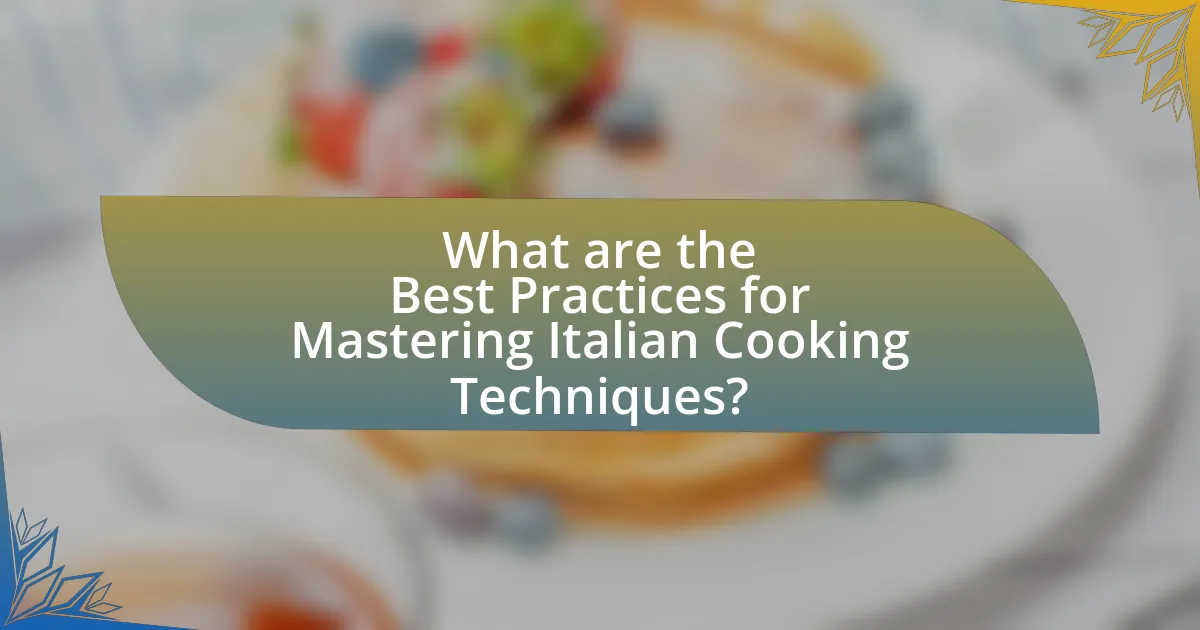
What are the Best Practices for Mastering Italian Cooking Techniques?
To master Italian cooking techniques, focus on using high-quality ingredients, understanding traditional methods, and practicing essential skills. High-quality ingredients, such as fresh produce, authentic Italian cheeses, and premium olive oil, enhance flavor and authenticity. Understanding traditional methods, like making pasta from scratch or mastering the art of risotto, is crucial as these techniques are foundational to Italian cuisine. Practicing essential skills, such as knife techniques and proper seasoning, ensures consistency and improves overall cooking proficiency. These practices are supported by the emphasis on quality and tradition in Italian culinary education, which highlights the importance of ingredient selection and technique mastery for achieving authentic results.
How can beginners effectively learn these techniques?
Beginners can effectively learn Italian cooking techniques by engaging in hands-on practice, utilizing instructional resources, and seeking feedback. Practical experience in the kitchen allows beginners to apply techniques such as sautéing, simmering, and pasta making, which are fundamental to Italian cuisine. Utilizing resources like cookbooks, online tutorials, and cooking classes provides structured guidance and visual demonstrations that enhance understanding. Additionally, seeking feedback from experienced cooks or instructors helps refine skills and correct mistakes, leading to improved proficiency. Research indicates that active learning methods, such as practice and feedback, significantly enhance skill acquisition in culinary arts.
What resources are available for learning Italian cooking?
Online platforms such as MasterClass, Udemy, and Coursera offer comprehensive courses on Italian cooking, featuring renowned chefs and structured lessons. Additionally, cookbooks like “Essentials of Classic Italian Cooking” by Marcella Hazan and “The Silver Spoon” provide authentic recipes and techniques. Furthermore, YouTube channels dedicated to Italian cuisine, such as Gennaro Contaldo and Pasta Grannies, present visual demonstrations that enhance learning. These resources collectively support a thorough understanding of Italian cooking techniques.
How can practice improve your skills in Italian cooking?
Practice enhances skills in Italian cooking by allowing individuals to refine techniques, develop a deeper understanding of ingredients, and improve their ability to execute recipes accurately. Repeatedly preparing dishes helps in mastering essential skills such as knife techniques, sauce preparation, and pasta making, which are fundamental to Italian cuisine. Studies indicate that deliberate practice leads to significant improvements in culinary skills, as it enables cooks to identify and correct mistakes, experiment with flavors, and gain confidence in their cooking abilities. For instance, a study published in the Journal of Culinary Science & Technology found that consistent practice over time resulted in higher proficiency levels among culinary students, demonstrating the direct correlation between practice and skill enhancement in cooking.
What common mistakes should beginners avoid?
Beginners in Italian cooking should avoid common mistakes such as neglecting ingredient quality, skipping mise en place, and overcooking pasta. Using low-quality ingredients can lead to subpar dishes, as Italian cuisine emphasizes fresh, high-quality produce and meats. Skipping mise en place, or the preparation of ingredients before cooking, can result in disorganization and mistakes during the cooking process. Overcooking pasta is a frequent error; authentic Italian pasta should be cooked al dente, which means firm to the bite, ensuring the best texture and flavor. These mistakes can significantly impact the overall quality of the dish and the cooking experience.
How can overcooking affect the flavor of Italian dishes?
Overcooking can significantly diminish the flavor of Italian dishes by causing ingredients to lose their natural taste and texture. For instance, overcooked pasta becomes mushy, losing its al dente quality, which is essential for the desired mouthfeel and flavor absorption in sauces. Additionally, overcooking vegetables can lead to a loss of vibrant flavors and nutrients, resulting in a bland dish. Research indicates that cooking vegetables beyond their optimal time can cause a reduction in key flavor compounds, such as glucosinolates in cruciferous vegetables, which are often used in Italian cuisine. Therefore, precise cooking times are crucial to maintain the authentic flavors characteristic of Italian dishes.
Why is it important to respect traditional cooking times?
Respecting traditional cooking times is crucial because it ensures the proper development of flavors and textures in dishes. For instance, slow-cooked sauces like ragù require extended simmering to allow the ingredients to meld and deepen in flavor, which is a hallmark of authentic Italian cuisine. Historical practices in Italian cooking emphasize that these times are rooted in cultural traditions, where specific durations have been perfected over generations to achieve the desired culinary results. Therefore, adhering to these times not only preserves the integrity of the dish but also honors the culinary heritage that defines Italian cooking.
What tips can enhance your Italian cooking experience?
To enhance your Italian cooking experience, focus on using high-quality, fresh ingredients. Fresh produce, authentic Italian cheeses, and premium olive oil significantly elevate the flavor of dishes. For instance, using San Marzano tomatoes instead of standard varieties can enhance the taste of sauces due to their unique sweetness and low acidity. Additionally, mastering basic techniques such as making homemade pasta or properly sautéing garlic can improve your skills and the authenticity of your dishes. Engaging with traditional recipes and understanding regional variations in Italian cuisine will also deepen your appreciation and execution of the cooking process.
How can you experiment with flavors while staying authentic?
To experiment with flavors while staying authentic in Italian cooking, incorporate traditional ingredients in innovative ways. For example, use classic herbs like basil or oregano but combine them with modern techniques such as sous-vide cooking to enhance their flavors without losing authenticity. This approach respects the foundational elements of Italian cuisine while allowing for creative expression. Historical context shows that Italian cooking has always evolved, with regional variations adapting to local ingredients and tastes, thus proving that authenticity can coexist with experimentation.
What are some simple recipes to practice these techniques?
Some simple recipes to practice Italian cooking techniques include Spaghetti Aglio e Olio, Caprese Salad, and Risotto. Spaghetti Aglio e Olio involves sautéing garlic in olive oil and tossing it with cooked spaghetti, showcasing the technique of emulsifying flavors. Caprese Salad combines fresh mozzarella, tomatoes, and basil, emphasizing the importance of ingredient quality and presentation. Risotto requires stirring Arborio rice with broth gradually, demonstrating the technique of slow cooking and achieving creamy texture. These recipes are foundational in Italian cuisine and provide practical experience in essential cooking methods.










